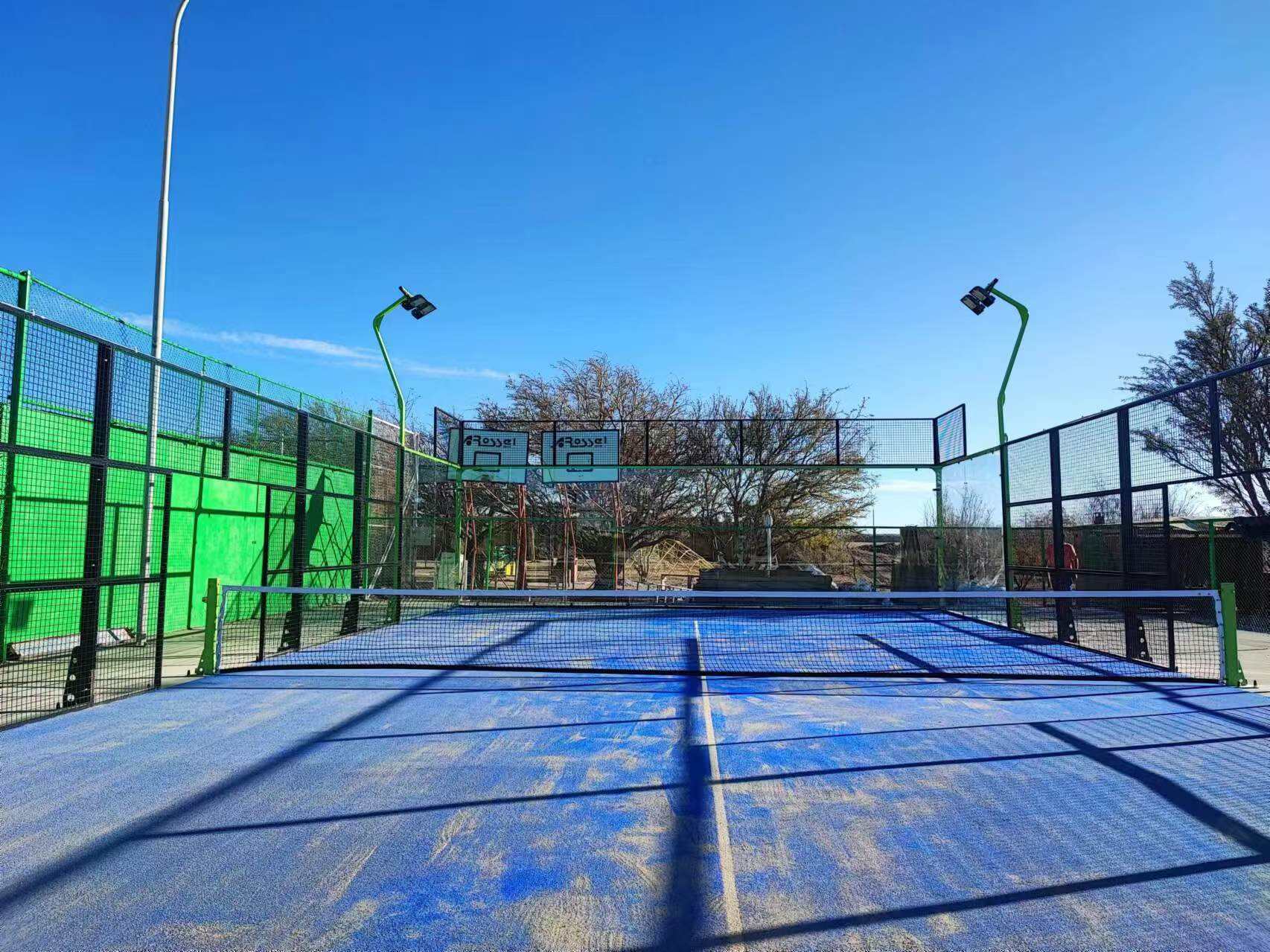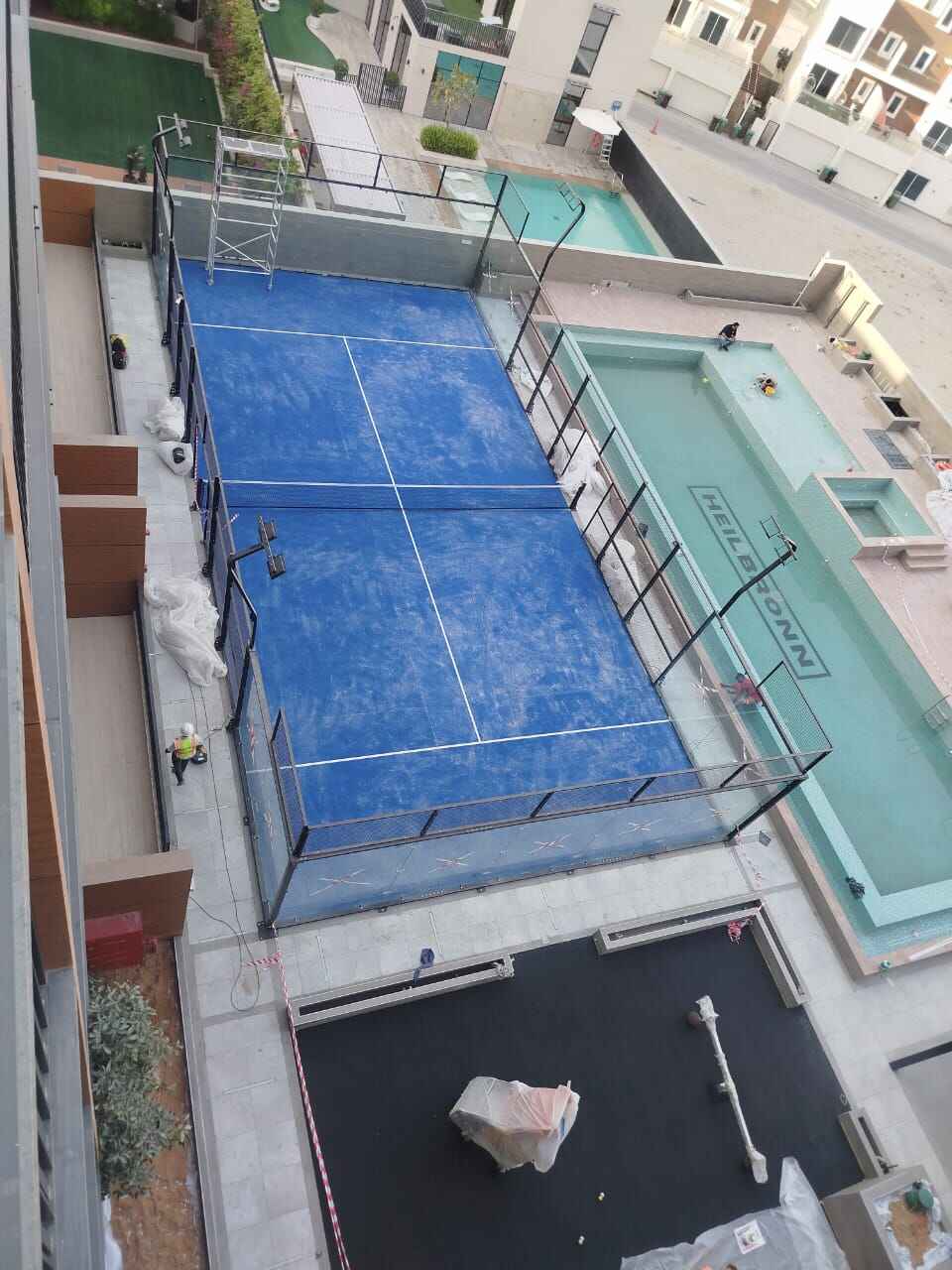คู่มือสำคัญเกี่ยวกับการให้แสงสว่างสำหรับสถานที่เล่นแพดเดิล
ความสำเร็จของสถานที่เล่นแพดเดิลขึ้นอยู่กับการออกแบบระบบแสงสว่างและการออกแบบโครงสร้างเป็นสำคัญ เนื่องจากกีฬาแพดเดิลกำลังได้รับความนิยมเพิ่มขึ้นทั่วโลก เจ้าของและผู้จัดการสถานที่ควรเข้าใจว่าการจัดระบบแสงสว่าง สนามพาดเล และการจัดวางโครงสร้างสามารถเพิ่มประสบการณ์การเล่นของผู้เล่นและเพิ่มชั่วโมงการใช้งานสนามได้อย่างไร คู่มือนี้จะนำเสนอแนวทางที่ทันสมัยเกี่ยวกับระบบ สนามพาดเล การให้แสงสว่างและโครงสร้างที่สามารถเปลี่ยนสถานที่ของคุณให้กลายเป็นจุดหมายปลายทางสำหรับการเล่นอันดับหนึ่ง

โซลูชันระบบแสงสว่างสำหรับสนามแพดเดิลในยุคปัจจุบัน
การนำเทคโนโลยี LED มาใช้
ระบบส่องสว่างแบบ LED ได้ปฏิวัติการให้แสงสว่างในสนามแพดเดิล ด้วยความสว่างที่เหนือกว่า ประสิทธิภาพในการใช้พลังงานที่ดีกว่า และอายุการใช้งานที่ยาวนาน ตัวโคมไฟ LED รุ่นใหม่สามารถให้แสงสว่างที่สม่ำเสมอทั่วทั้งพื้นที่สนาม ช่วยกำจัดจุดอับหรือเงาที่อาจส่งผลต่อการแข่งขัน ระบบเหล่านี้มีอายุการใช้งานโดยเฉลี่ยระหว่าง 50,000 ถึง 100,000 ชั่วโมง ซึ่งช่วยลดค่าใช้จ่ายในการบำรุงรักษาและลดความถี่ในการเปลี่ยนอุปกรณ์อย่างมาก
โซลูชัน LED ขั้นสูงยังมีคุณสมบัติการสตาร์ททันที ซึ่งช่วยกำจัดปัญหาการรอให้หลอดอุ่นเครื่องเหมือนระบบฮาโลเจนเมทัลฮาไลด์แบบดั้งเดิม ความสามารถนี้ช่วยให้ผู้จัดการสถานที่สามารถตอบสนองต่อความต้องการด้านแสงสว่างที่เปลี่ยนแปลงได้อย่างรวดเร็ว รวมถึงดำเนินการโปรแกรมประหยัดพลังงานได้อย่างมีประสิทธิภาพในช่วงเวลาที่ไม่ได้ใช้งาน
ข้อกำหนดและมาตรฐานระดับความสว่าง
สนามพัดเดิลระดับมืออาชีพต้องมีแสงสว่างที่เป็นไปตามมาตรฐานการส่องสว่างเฉพาะ เพื่อให้สภาพการเล่นอยู่ในระดับที่เหมาะสมที่สุด โดยระดับแสงที่แนะนำสำหรับการเล่นเพื่อความบันเทิงคือประมาณ 300-500 ลักซ์ ส่วนการแข่งขันระดับมืออาชีพต้องการระดับแสง 750-1000 ลักซ์ การกระจายแสงอย่างสม่ำเสมอถือเป็นสิ่งสำคัญ โดยอัตราส่วนความสม่ำเสมอขั้นต่ำที่แนะนำคือ 0.7 เพื่อป้องกันจุดแสงสว่างหรือเงาที่อาจรบกวนผู้เล่น
ตำแหน่งการติดตั้งโคมไฟมีบทบาทสำคัญในการบรรลุมาตรฐานดังกล่าว โดยส่วนใหญ่แล้วการติดตั้งจะใช้จุดยึดติดตั้ง 4-6 จุดต่อสนาม และปรับมุมของโคมไฟอย่างระมัดระวังเพื่อลดการสะท้อนรบกวนและให้แสงสว่างทั่วถึงอย่างสม่ำเสมอตลอดพื้นที่สนาม
การออกแบบและวัสดุของโครงสร้างปิด
ข้อกำหนดของแผงกระจก
แผ่นกระจกที่ใช้ในสนามพัดเดิลต้องเป็นไปตามข้อกำหนดด้านความปลอดภัยและการใช้งานอย่างเคร่งครัด แผ่นกระจกนิรภัย (Tempered glass) ที่มีความหนาโดยทั่วไป 10-12 มม. สามารถทนทานและต้านทานแรงกระแทกได้ดี พร้อมทั้งให้ความชัดเจนในการมองเห็นที่ยอดเยี่ยมทั้งสำหรับผู้เล่นและผู้ชม แผ่นกระจกเหล่านี้ได้รับการบำบัดเป็นพิเศษเพื่อป้องกันการแตกสลายและรักษาความแข็งแรงของโครงสร้างแม้ในสภาวะการเล่นที่เข้มข้น
การติดตั้งกระจกในปัจจุบันมักมีการเคลือบเพื่อลดการสะท้อนแสงและป้องกันรังสีอัลตราไวโอเลต ทำให้การเล่นเป็นไปอย่างสะดวกไม่ว่าจะเป็นสภาวะแสงหรือเวลาใดก็ตาม ความโปร่งใสของกระจกยังช่วยเสริมสร้างด้านสังคมของกีฬาพัดเดิล โดยให้ผู้ชมสามารถมองเห็นการแข่งขันจากหลายมุมมองได้อย่างชัดเจน
องค์ประกอบโครงสร้างโลหะ
โครงสร้างโลหะรองรับของสนามพาเดลต้องได้รับการพิจารณาอย่างรอบคอบทั้งในด้านการออกแบบและวัสดุ โครงสร้างเหล็กชุบสังกะสีเคลือบสารป้องกันสภาพอากาศ ให้ความแข็งแรงและอายุการใช้งานที่ยาวนานสำหรับการติดตั้งภายนอกอาคาร โครงสร้างต้องรองรับไม่เพียงแต่แผงกระจกเท่านั้น แต่ยังรวมถึงโคมไฟด้วย ในขณะเดียวกันก็ต้องรักษาความสวยงามและความสมบูรณ์ของโครงสร้างเอาไว้
ระบบสารเคลือบขั้นสูงในปัจจุบันสามารถให้การปกป้องที่เพิ่มขึ้นจากสนิมและความเสียหายจากแสง UV ซึ่งช่วยยืดอายุการใช้งานของชิ้นส่วนโลหะออกไปอย่างมาก การออกแบบโครงสร้างยังต้องคำนึงถึงการระบายน้ำและการระบายอากาศที่เหมาะสม เพื่อป้องกันการสะสมของความชื้นและรักษาสภาพการเล่นให้อยู่ในระดับที่เหมาะสมที่สุด
ข้อพิจารณาด้านสิ่งแวดล้อมและประสิทธิภาพการใช้พลังงาน
โซลูชันแสงสว่างที่ยั่งยืน
ระบบไฟส่องสว่างสำหรับสนามเพดดิลที่มีประสิทธิภาพในการใช้พลังงานมีส่วนช่วยอย่างมากต่อความยั่งยืนด้านสิ่งแวดล้อมและการลดต้นทุนการดำเนินงาน ระบบ LED รุ่นใหม่สามารถประหยัดพลังงานได้มากถึง 75% เมื่อเทียบกับระบบส่องสว่างแบบดั้งเดิม พร้อมทั้งให้คุณภาพการส่องสว่างที่ดีกว่า นอกจากนี้ ระบบควบคุมอัจฉริยะยังสามารถปรับการใช้พลังงานให้เหมาะสมยิ่งขึ้น โดยปรับระดับความสว่างตามสภาพแสงธรรมชาติและการใช้งานสนาม
การติดตั้งเซ็นเซอร์ตรวจจับการเคลื่อนไหวและระบบจัดตารางเวลาอัตโนมัติ ช่วยลดการใช้พลังงานที่ไม่จำเป็นในช่วงเวลาที่ไม่ได้ใช้งานอย่างหนัก เทคโนโลยีเหล่านี้มีประโยชน์อย่างมากสำหรับสถานที่ที่ตั้งอยู่ในพื้นที่ที่มีสภาพอากาศเปลี่ยนแปลงบ่อย หรือเปิดให้บริการเป็นเวลานาน
การควบคุมสภาพอากาศแบบบูรณาการ
การออกแบบโครงสร้างปิดล้อมจะต้องคำนึงถึงสภาพภูมิอากาศในท้องถิ่นและติดตั้งระบบระบายอากาศที่เหมาะสม การไหลเวียนของอากาศที่ดีมีความสำคัญต่อความสบายของผู้เล่น และอาจส่งผลต่ออายุการใช้งานขององค์ประกอบสนาม ระบบโครงสร้างปิดล้อมขั้นสูงอาจรวมถึงคุณสมบัติควบคุมสภาพอากาศแบบบูรณาการ เช่น แผงระบายอากาศ หรือส่วนหลังคาที่สามารถเก็บเข้า-ออกได้ เพื่อเพิ่มความยืดหยุ่นระหว่างการใช้งานในร่มและกลางแจ้ง
ระบบเหล่านี้สามารถเชื่อมต่อกับระบบควบคุมแสงสว่าง เพื่อรักษาสภาพการเล่นให้เหมาะสมตลอดทั้งฤดูกาลและสภาพอากาศที่แตกต่างกัน การผสานรวมคุณสมบัติควบคุมสภาพอากาศสามารถช่วยยืดเวลาการเปิดดำเนินการของสถานที่ได้อย่างมาก และเพิ่มประสบการณ์การเล่นของผู้เล่น
คำถามที่พบบ่อย
การติดตั้งแสงสว่างแบบใดที่เหมาะสมที่สุดสำหรับสนามเพดดิล?
การติดตั้งระบบไฟส่องสว่างสำหรับสนามเพดดิลที่เหมาะสมที่สุด โดยทั่วไปประกอบด้วยโคมไฟ LED จำนวน 4-6 ดวง ติดตั้งไว้ ณ จุดสำคัญรอบสนาม เพื่อให้ให้ความสว่างระดับ 300-500 ลักซ์สำหรับการเล่นเพื่อความบันเทิง และสูงถึง 1000 ลักซ์สำหรับการแข่งขันระดับมืออาชีพ โคมไฟควรติดตั้งในตำแหน่งที่ช่วยลดแสงจ้า และรับประกันการกระจายแสงที่สม่ำเสมอทั่วพื้นสนาม
โคมไฟสนามแบบ LED โดยทั่วไปมีอายุการใช้งานนานเท่าไร?
ระบบไฟ LED คุณภาพดีสำหรับสนามเพดดิลมีอายุการใช้งานระหว่าง 50,000 ถึง 100,000 ชั่วโมง การใช้งาน ซึ่งเทียบเท่ากับการใช้งานปกติประมาณ 10-20 ปี ขึ้นอยู่กับจำนวนชั่วโมงในการเปิดใช้งานต่อวัน และการบำรุงรักษา
วัสดุใดเหมาะสมที่สุดสำหรับทำโครงสร้างล้อมรอบสนามเพดดิล?
วัสดุที่เหมาะสมที่สุดสำหรับทำโครงสร้างล้อมรอบสนามเพดดิล ได้แก่ แผ่นกระจกนิรภัยแบบเทมเปอร์ (หนา 10-12 มม.) สำหรับผนัง และเหล็กชุบกัลวาไนซ์ที่มีชั้นเคลือบป้องกันสำหรับโครงสร้างหลัก วัสดุเหล่านี้ให้ความทนทาน ความปลอดภัย และคุณสมบัติการเล่นที่เหมาะสม พร้อมทั้งต้องการการบำรุงรักษาเพียงเล็กน้อย

